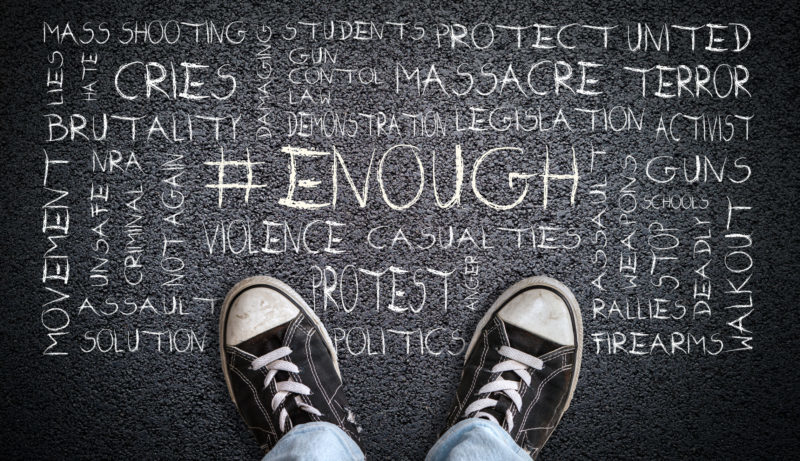By Nancy Kislin, LCSW
It’s no surprise that children are being traumatized by the fear of being shot to death in school. Monthly lockdown drills, active shooter drills and evacuation drills are causing anxiety and depression in children.
The sad reality is that American school children today live with long-lasting trauma related to the threat of or witnessing a school shooting. They also endure the collateral damage of experiencing lockdown drills.
The statistics are disturbing
More than 187,000 school students have been exposed to gun violence since the Columbine school shooting in 1999, where 13 students were killed. In the Sandy Hook school shooting 26 lost their lives, another 17 were killed at Marjory Stoneman Douglas in 2018.
These days, students learn about the news in real time. A school shooting happens in Florida and a teen in California is hyper-focused on how many kids are dead as he stares hopelessly into the screen of his smartphone.
He wonders, “Could this happen here?” or even “When will this happen here?”
We live in a world in which high school students talk about whether jumping out of a second-floor classroom window is safer than getting shot by an intruder. Children are coming of age in a time when the basic assumption “I will be safe at school” no longer holds true.
In a world where lockdown drills are becoming normal practice, I wanted to know how social workers can talk to clients, children and their parents without causing further alarm and anxiety.
In preparation for writing my book, Lockdown, Talking To Your Children About School Violence, I interviewed hundreds of children and parents seeking to understand how kids are doing in this climate of fear. I learned that many children are feeling anxious about school safety.
I learned that many children worry about going to the bathroom during the school day because of fear that a lockdown drill will occur while they are on the way or when they were in the bathroom. A worst case scenario for a student is being in the bathroom during a drill. “I don’t want to die alone,” was a statement I heard over and over again.
My interviews revealed that students don’t like going into classrooms where they don’t know anyone. This isn’t unusual when, in many schools, if you are in the hallway during a drill you have to go into the nearest classroom to hide.
Children are really scared
A 12-year-old girl demands that her mother buy her an Apple watch. “Mom I have to have an Apple watch!” she says. “I have no way to call you to say goodbye when a shooter enters my school.” Her voice was filled with intensity.
Her mother looked at her daughter in disbelief. The daughter explained that sixth graders were not permitted to bring their phones to class but they could wear Apple watches.
What can parents and guardians do?
Acknowledge: It is important that the mom acknowledge her daughter’s concern. “Wow, I didn’t know you were worried about being safe in school,” or, “Do you worry about being safe while you are in school?”
Respond to the fear behind the request: It’s key not to get caught up in the discussion. Rather than focus on buying a watch, get curious about what your child fears, the frequency, and let your child know you are there to talk about these feelings.
Reassure: Remind your kids that millions of kids go to school each day and are safe. Remind them that their teachers and school staff are trained to keep them safe.
Lockdown drills traumatize students
There is power in knowledge and I invite you to become part of the conversation about lockdowns, school safety protocols and how your client’s are doing in this climate.
I want you to imagine that you are in elementary school. You are sitting in a classroom focused on your teacher’s lecture or working on a project with your partner. The lesson is interrupted by the principal’s voice over the loudspeaker:
“Lockdown! Lockdown! Lockdown!” is repeated as the teacher motions to the students to run to their hiding places as she runs to the classroom door. She reminds her students to take their bag of rocks with them. She opens the door, looks out into the hallway to see if anyone is there. If any child is in the hallway – she tells them to go into her room.
She then closes the door and locks it.
The teacher turns off the lights, moving quickly to the windows and pulls down the shades. She joins the students in their hiding places. They all sit huddled behind desks, or in a supply closet, or younger kids hide between hanging coats. The students are “armed and trained” to throw their rocks at the shooter.
They do not know if it is a drill or the real thing.
The children and the teacher wait wait, not sure if a shooter is going to enter their classroom.
Variations of this drill happen every day in schools throughout the United States – from preschool through college.
Finally, after 10 minutes, a voice over the loudspeaker announces that the lockdown is over.
Imagine the students trying to get right back to classwork as if nothing happened.
That’s right. Students are expected to go right back to what they were doing before the lockdown.
How are you feeling?
Parents and guardians should become familiar with the various safety drills — active shooter drills, shelter in place drills and lockdown drills. They should also:
Get informed: Parents should ask that schools notify them when a drill occurs.
Take action: Parents and guardians should ask their children’s schools about the policy for lockdown drills. How frequent are they? Urge the school to email all parents at the conclusion of the drill.
Be aware: Parents should look for signs that their children may be affected by the drills.
Don’t be afraid to ask questions: Learn more about the procedures and how the school created their current plan. How do teachers feel about the procedures? How are the children are coping with the drills?
Share coping skills with your child: Breathing and grounding exercises can help them when they are waiting in the dark.
Teach techniques to help children stay calm: Giving your child a focus can help calm them in the moment and can be a way of connecting at home. Teach your child to breathe in for the count of three – hold their breath for the count of three – exhale for the count of three. Do this three times. Then they can do this tightening muscle exercise: Tighten all the tiny, little muscles in their toes. Ask them to imagine they are closing them really tightly. Count to three. Next release all the muscles in their toes. Do the same thing for every part of their body, moving up from the legs.You can remind them that a child can do this exercise with their eyes open and no one needs to know they are doing it.
Arming children with rocks, other weapons does not address the larger issue of school violence
A concerned mother approached me after a presentation to inform me that her daughter’s second grade teacher took her class on a field trip. Each child was handed a large zip-lock bag before they went outside. The children were directed to fill their bags with rocks.
Once back inside, the children were directed to store their bags of rocks inside their desk. They were to retrieve their bags every time there was a lockdown drill. The teacher clearly stated the bags of rocks were to be used as weapons to throw at a shooter when he/she entered their classroom.
I heard many stories where teachers encouraged children to arm themselves.
I don’t believe it is good for a child’s mental and emotional well being to arm them with rocks in anticipation of a shooter. Every time a child opens their desk, it can trigger their fear that a shooter may come to their school to kill them.
I don’t believe that arming children with rocks, golf clubs, baseball bats and other items is an effective method to stop school shootings. I am concerned that this practice increases the level of anxiety and trauma in children and teachers.
 National Association of Social Workers (NASW) member Nancy Kislin, LCSW, is author of “Lockdown, Talking to Your Kids About School Violence.” She is a psychotherapist, licensed clinical social worker and parent coach. You can find out more about the book and handling challenging conversations around school drills at lockdownbook.com.
National Association of Social Workers (NASW) member Nancy Kislin, LCSW, is author of “Lockdown, Talking to Your Kids About School Violence.” She is a psychotherapist, licensed clinical social worker and parent coach. You can find out more about the book and handling challenging conversations around school drills at lockdownbook.com.





